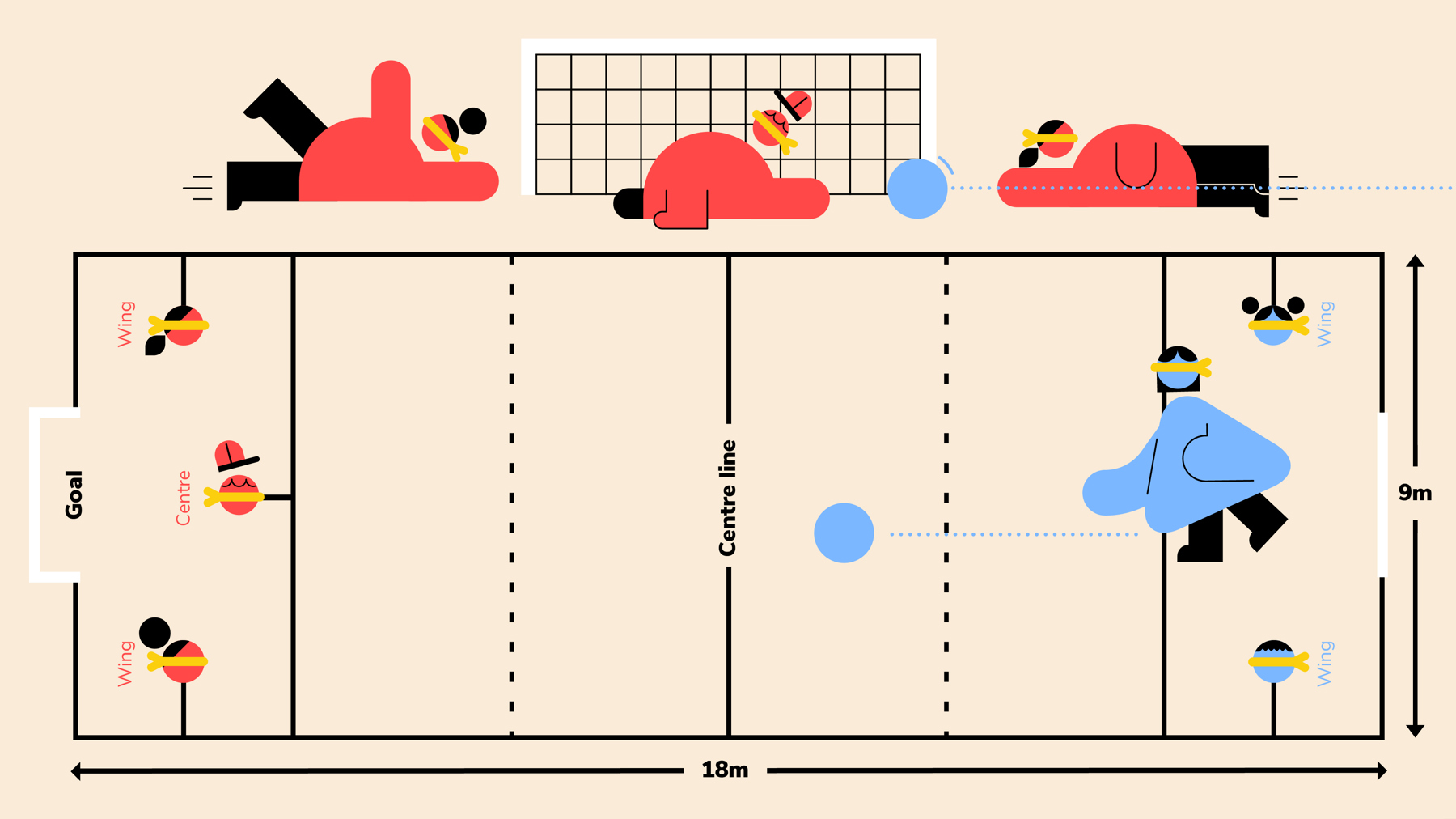
Goalball
You’ll need
- Scarves (such as neckers)
- Something to mark lines (for example, chalk, masking tape, or rope)
- Goalball (a ball with a bell inside), or a ball wrapped in a plastic bag that rustles

Before you begin
- Following the court diagram above, mark out the Goalball court using masking tape.
- You may need to clean the floor (or warn people to wear old clothes) as everyone will be rolling around on the floor).
Practice without blindfolds
We’ve adapted the official rules into a slightly simpler version.
- Split into teams of three people. Two teams can play at one time. We’ll call them the red team and the blue team, to make it easier to explain.
- The first two teams should go onto the court and stand by their goals. Everyone else is a spectator. Spectators must be silent so players can hear the ball.
- The red team defend first, so they should get into the ‘ready position’ by crouching on their toes with their fingers resting along one of the lines of the court. One player should be on the centre line, and one player should be on each of the wing lines.
- One person in the blue team should attack and try to score a goal. They should bowl the ball, like in ten-pin bowling. They should aim for the goal, and release the ball close to the floor so it makes less noise.
- The red team should try to stop the ball going in the goal by moving into the ‘barrier position’. They should stretch out along the line their fingers were on, making their legs straight and their arms stretched. Their hands should face the ball, and they should use one arm to protect their face as they try to stop the ball (ideally with their tummy or thighs).
- If the blue team gets the ball completely over the goal line they score a goal. The person leading the game should give the ball to a member of the red team. If the red team catches the ball, they should hold on to it (and the blue team doesn’t score anything).
- One person in the red team (usually the person who caught or was given the ball) should repeat step four to try and score, while the blue team repeats step five to stop the ball going in the goal.
- Both teams should have three turns—each player should have a turn at attacking (even if they don’t catch or get given the ball, their teammates can pass it to them so they can give it a go).
Play the game blindfolded
- Everyone should help each other to put on blindfolds.
- Teams should play the game again, following the same rules as above. This time, they’ll have to listen for the ball (and feel the lines) to try and attack and defend.
- Each team should play for a certain time, or until they’ve all had a certain number of chances to attack. The team that scores the most goals is the winner.
Reflection
This activity was a chance to be a team player. You had to work with your team to score and defend your goals. Did you work well as a team? How did you work together when you couldn’t see? Did you have to remember where the other members of your team were on the court? What other skills did you use?
Goalball is designed for disabled athletes. It was developed after the second world war to help veterans (people who had been in the armed forces during the war) with visual impairments with their rehabilitation—to help people who had been in the armed forces during the war get back living a ‘normal’ life.
This activity also needed you to care. Close your eyes, and listen to the sounds in the room. Would you miss lots of these sounds if you were talking and looking around? How do you think it feels to find a game you can join in, if you’re often left out of sports? Goalball has simple rules, but it can get really tactical too. We choose how we play games, and we can often change the rules so everyone can join in. Why is it important to make it so that everyone can play?
Safety
All activities must be safely managed. You must complete a thorough risk assessment and take appropriate steps to reduce risk. Use the safety checklist to help you plan and risk assess your activity. Always get approval for the activity, and have suitable supervision and an InTouch process.
- Active games
The game area should be free of hazards. Explain the rules of the game clearly and have a clear way to communicate that the game must stop when needed. Take a look at our guidance on running active games safely.
- If you want to play a simpler version, don’t mark out the court in such detail.
- If you have enough space, you could split into two teams and play as a whole group.
- Goalball involves a lot of tactics—everyone should experiment with rolling the ball quickly or slowly, with different amounts of force, or aiming differently.
- You could play a Goalball challenge game, for example, circle ball or hit the wall. You can find Goalball challenges online.
- You could play sitting on the floor.
- No one has to wear a blindfold—they could close their eyes instead. Anyone who doesn’t want to close their eyes can still join in with the practice.
- Team games can be trickier for anyone with an additional need (such as autism) that affects communication or social skills. It may be useful to speak to parents and carers to find out about any specific work they’re doing at school or home. You can adjust the size of the team or the group depending on the young person’s needs—this could include working in a pair or a group of three. You can also adjust time periods and quantities.
- Don’t assume everyone will automatically know why teamwork is positive, or what teamwork looks like. You may want to spend some time exploring the benefits of working in a team, for example, teams can often get more done; different people are good at different things so they bring different ideas and skills; and it’s a good way to make friends.
All Scout activities should be inclusive and accessible.

